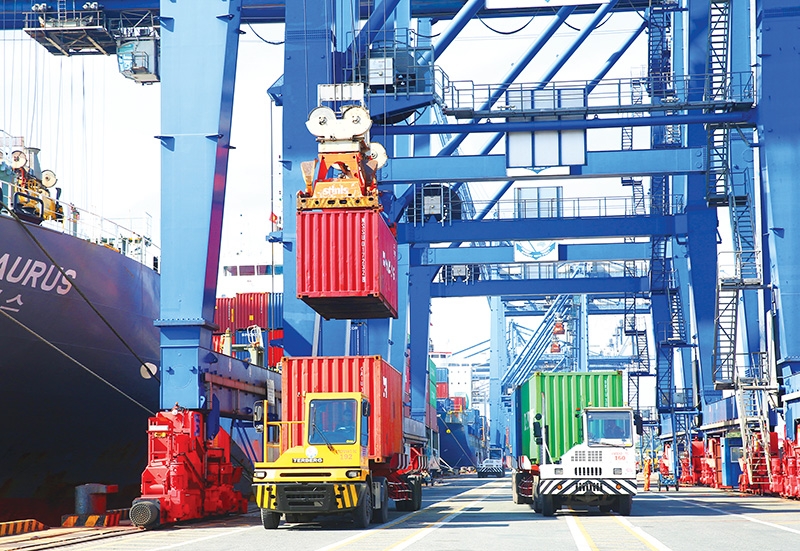Bright spots for trade in Asia
 |
| Dr. Deborah Elms - Executive director Asian Trade Centre Singapore |
But there are some encouraging points of light in an otherwise gloomy landscape.
Last month the 21 member economies in the Asia-Pacific Economic Cooperation (APEC) held a virtual meeting of trade ministers. The meeting, and final statement, focused on a number of important issues including the necessity of keeping trade lanes open for critical medical supplies and other essential goods, supporting developing countries and smaller businesses in this uncertain landscape, and providing backing to the World Trade Organization (WTO).
APEC members are working on a wide variety of topics this year, but a key objective is to create a post-2020 vision before the annual leaders’ meeting in November. The introduction of a pandemic has made this work more urgent than ever, as collective action is needed to drive growth and jobs across the world in the new normal.
Two important groupings have big milestones in August. First, the members of the Comprehensive and Progressive Trans-Pacific Partnership (CPTPP) met last week.
The CPTPP, which still has no secretariat to manage this sprawling and complex trade agreement, is instead driven by a series of meetings across the year by government officials working on various aspects of the deal. The primary mechanism for oversight is the CPTPP Commission, which will be held virtually under Mexico’s chairmanship this year.
This commission meeting should be notable for a few reasons. First, it is an opportunity to celebrate the achievements of the agreement after more than 18 months in operation. While trade flows remain depressed under the pandemic, governments like Vietnam have taken advantage of the opportunity to expand knowledge. Vietnam held 577 seminars and workshops in 2019 alone to encourage the proper utilisation of the CPTPP by businesses of all sizes across the country.
Second, the commission will review any issues that have emerged in implementation. An agreement that runs to nearly 600 pages with thousands of country-specific commitments is bound to have a few issues. As a simple example, a typo in one of the letters mentioned yams instead of yarn.
While the CPTPP rulebook is extensive, in many areas it is remarkably thin. For instance, the CPTPP allows for advanced rulings on issues like tariff classification and rules of origin, but it does not actually say how such things will be done or how members will recognise rulings between parties. These are implementation details that have to be reviewed regularly to ensure that the spirit and intent of the provisions are applied on the ground. If there are issues, members have to address these challenges in various committee meetings and report solutions to the commission at the annual meeting.
Finally, and perhaps of most interest to outsiders, the commission is the body tasked with managing accession of new members.
 |
| The RCEP will be an impactful new trade arrangement, with commitments in around 20 chapters.(Photo Le Toan) |
The list of potential new members is not terribly long, and 2020 has made it even more challenging for some candidates to consider membership at this time. All of the institutions attached to trade, including trade ministries, customs agencies, and political leadership have been distracted by a wide variety of policies and programmes aimed at managing and mitigating COVID-19 damage.
Nevertheless, the commission will be reviewing the entry requirements for new members and considering possible candidates for admission. While the original TPP had a strict rule to prohibit “observer” status for potential members to ensure that only committed participants joined the ongoing negotiations, the CPTPP members may want to find a new pathway to allow a small handful of interested countries to start becoming familiar with the agreement and working through issues related to formal membership.
The commission is only scheduled to meet once a year, so missing this opportunity to expand means a lengthy delay. At a time of such unsettled trade relationships, it is problematic to have promising candidates wait even longer to start working on membership.
Meanwhile, also this month the five active members (Australia, Japan, New Zealand, Singapore, and Vietnam) are wrapping up work on the Regional Comprehensive Economic Partnership (RCEP).
The 15 participating countries in RCEP (the ASEAN, Australia, China, Japan, New Zealand, and South Korea) are due to sign the agreement in November. This means the final texts and schedules need to be completed in August to allow sufficient time for member governments to review the final details.
The legal scrubbing of the RCEP has taken some time, as there were several fast and furious changes at the end of last year when talks were getting down to the wire. Not all of the bilateral commitments between members over tariff cuts were fully completed and the matching rules of origin work has also taken time to conclude. Switching to virtual negotiations has also slowed progress in some areas.
However, all the necessary work for the RCEP should be completed next month as the agreement heads towards signature in November. Once signed, it will likely take until January 2022 to enter into force, as the agreement needs to obtain domestic-level approval in at least six ASEAN member states plus three of the five ASEAN dialogue partners.
The RCEP will also be a sprawling trade arrangement, with commitments in 20 or so chapters, including goods, services, investment, intellectual property rights, standards, cooperation and development, micro-sized and small enterprises, and much more. The institutional arrangements are important – the RCEP needs a dedicated secretariat to manage implementation and provide the kind of sustained attention to the agreement that is necessary if it is to have a significant impact on trade in Asia.
Overall, Asia continues to have some bright spots of promise on trade and economics. Governments in the region have largely recognised the importance of keeping goods, services and investments moving and have taken critical steps to keep up momentum. Such efforts should be encouraged.
| The APEC ministers responsible for trade reaffirm their commitment to effectively mitigate the economic impact of the COVID-19 pandemic and promptly navigate the region towards a path of resilient, sustainable, inclusive and expedited economic recovery. They acknowledge the importance of a free, open, fair, non-discriminatory, transparent, and predictable trade and investment environment to drive economic recovery at such a challenging time. Recognising the World Trade Organization’s (WTO) role in this regard, ministers also agree that action is necessary to improve its functioning, and support the necessary reform of the WTO. The ministers are committed to ensure that emergency measures designed to tackle COVID-19 are targeted, proportionate, transparent, temporary, do not create unnecessary barriers to trade or disruption to global supply chains, and are consistent with WTO rules. While they acknowledge that economies may need to implement emergency measures designed to address COVID-19 challenges, ministers reiterate commitment to work to facilitate the flow of essential goods and services, enhance connectivity by strengthening supply chains resilience, and minimise disruptions to trade in medical goods, food and agriculture products, in order to fight the pandemic. Ministers also recognise the need for discussions to reduce non-tariff barriers which restrict trade in essential goods. They note the recommendations in the APEC Business Advisory Council report on COVID-19 on how to mitigate the immediate impact of the pandemic, accelerate economic recovery, and build resilience in the longer-term, including by pursuing an open market for goods, services and investment, supporting smaller businesses, and leveraging on digital connectivity. Ministers encourage economies to collaborate and adopt digital solutions that will strengthen supply chain resilience as well as enable seamless cross-border business, including through e-commerce. In harnessing the opportunities of the digital economy, ministers acknowledge the importance of cooperation on facilitating the flow of data and strengthening consumer and business trust in digital transactions. Finally, ministers direct senior officials to accelerate work towards delivering a concise, relevant, meaningful, and achievable post-2020 vision, and will look forward to its launch by the leaders at the end of the year. Source: Ministers responsible for trade virtual meeting joint statement 2020 (July 25) |
What the stars mean:
★ Poor ★ ★ Promising ★★★ Good ★★★★ Very good ★★★★★ Exceptional
 Tag:
Tag:
Themes: Drive ASEAN Forward
Related Contents
Latest News
More News
- 72 nations sign landmark Hanoi cybercrime convention (October 26, 2025 | 18:00)
- UN Secretary-General commends Vietnam’s global leadership (October 26, 2025 | 09:00)
- APEC finance ministers convene to tackle regional challenges (October 22, 2025 | 17:31)
- Rewiring global trade: ASEAN’s rise as supply chain hub (October 17, 2025 | 11:40)
- Vietnam attends first World Nuclear Week Forum in Russia (September 26, 2025 | 10:50)
- Vietnam attends 69th session of IAEA General Conference (September 16, 2025 | 10:00)
- ADB, WB pledge over 12 billion USD for ASEAN power grid, renewable energy projects (August 15, 2025 | 14:18)
- Lowy Institute proposes AI-based tobacco control solutions for ASEAN (August 15, 2025 | 14:14)
- Cloud computing policy to position Malaysia as regional hub by 2030 (August 15, 2025 | 14:11)
- Thailand, Cambodia suffer numerous cyber attacks (August 05, 2025 | 16:19)























 Mobile Version
Mobile Version